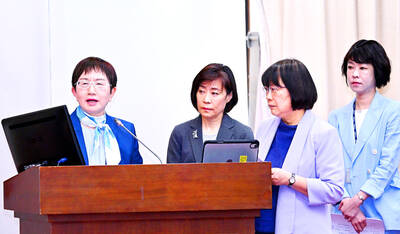The unemployment rate last month rose from the month before as expected, with more first-time jobseekers — mainly school-leavers — unable to find work, the Directorate-General of Budget, Accounting and Statistics (DGBAS) said yesterday.
The unemployment rate — a key indicator of economic performance — climbed for the second consecutive month to 4.21 percent last month, from 4.12 percent in May, the DGBAS said in its monthly report.
“The jobless rate last month showed a seasonal effect,” DGBAS Deputy Director Chen Min (陳憫) told a press conference.
Chen said the data reflected historical trends with the graduation season, and an influx of first-time jobseekers, often pushing up the unemployment rate from May to August.
The latest data showed that 477,000 people were unemployed last month, an increase of 11,000 from the previous month, with the number of first-time jobseekers failing to get a job rising by 13,000.
However, Chen said the labor market outlook in near future remained stable, as the number of workers losing their jobs through business closures or downsizing fell 22,000 in the first half.
Cheng Cheng-mount (鄭貞茂), chief economist at Citigroup in Taipei, told the Taipei Times that he expects the labor market to remain steady in the second half.
The seasonally-adjusted unemployment rate — a more accurate indicator of the long-term trend — which dropped 0.01 percentage points from a month ago to 4.24 percent, confirmed Cheng’s views.
On the working front, the number of those with jobs averaged 10.82 million in the first six months, up 1.63 percent from a year earlier, marking the lowest rise in three years, which indicated the conservative attitude of employers generating new positions, DGBAS said.
Henry Ho (何啟聖), public relations director of 1111 Job Bank (1111, 人力銀行), said in a note that a slowing supply of job openings could continue to drive up the number of first-time jobseekers failing to receive an employment offer over the next few months.
The DGBAS also unveiled the latest salary data yesterday which showed that the average national monthly salary in May was NT$37,419, up 1.83 percent from a year ago.
The average monthly salary was NT$37,262 in the January-to-May period, up 1.88 percent from a year earlier, DGBAS statistics showed.
However, when bonuses and other forms of compensation are included, the average monthly remuneration package was NT$50,050, which was a 0.71 percent markdown from a year earlier, reflecting the fact that employers were awarding lower year-end bonuses and other vocational rewards this year with the global economic slowdown impacting their business, the DGBAS said.

TECH CLUSTER: The US company’s new office is in the Shalun Smart Green Energy Science City, a new AI industry base and cybersecurity hub in southern Taiwan US chip designer Advanced Micro Devices Inc (AMD) yesterday launched an office in Tainan’s Gueiren District (歸仁), marking a significant milestone in the development of southern Taiwan’s artificial intelligence (AI) industry, the Tainan City Government said in a statement. AMD Taiwan general manager Vincent Chern (陳民皓) presided over the opening ceremony for the company’s new office at the Shalun Smart Green Energy Science City (沙崙智慧綠能科學城), a new AI industry base and cybersecurity hub in southern Taiwan. Facilities in the new office include an information processing center, and a research and development (R&D) center, the Tainan Economic Development Bureau said. The Ministry

ADVERSARIES: The new list includes 11 entities in China and one in Taiwan, which is a local branch of Chinese cloud computing firm Inspur Group The US added dozens of entities to a trade blacklist on Tuesday, the US Department of Commerce said, in part to disrupt Beijing’s artificial intelligence (AI) and advanced computing capabilities. The action affects 80 entities from countries including China, the United Arab Emirates and Iran, with the commerce department citing their “activities contrary to US national security and foreign policy.” Those added to the “entity list” are restricted from obtaining US items and technologies without government authorization. “We will not allow adversaries to exploit American technology to bolster their own militaries and threaten American lives,” US Secretary of Commerce Howard Lutnick said. The entities

Minister of Finance Chuang Tsui-yun (莊翠雲) yesterday told lawmakers that she “would not speculate,” but a “response plan” has been prepared in case Taiwan is targeted by US President Donald Trump’s reciprocal tariffs, which are to be announced on Wednesday next week. The Trump administration, including US Secretary of the Treasury Scott Bessent, has said that much of the proposed reciprocal tariffs would focus on the 15 countries that have the highest trade surpluses with the US. Bessent has referred to those countries as the “dirty 15,” but has not named them. Last year, Taiwan’s US$73.9 billion trade surplus with the US

The Taipei International Cycle Show (Taipei Cycle) yesterday opened at the Taipei Nangang Exhibition Center, with the event’s organizer expecting a steady recovery in the industry this year following a tough last year. This year, 980 companies from 35 countries are participating in the annual bicycle trade show, showcasing technological breakthroughs and market development trends of the bicycle industry at 3,600 booths, the Taiwan External Trade Development Council (TAITRA, 外貿協會) said in a statement. Under the theme “Ride the Revolution,” the exhibition has attracted more than 3,500 international buyers from 80 countries to preregister for the four-day event, which is expected to